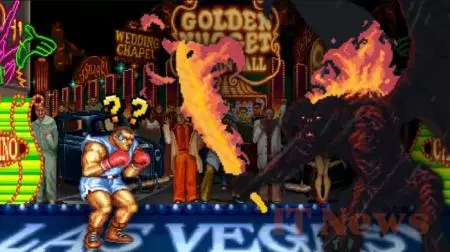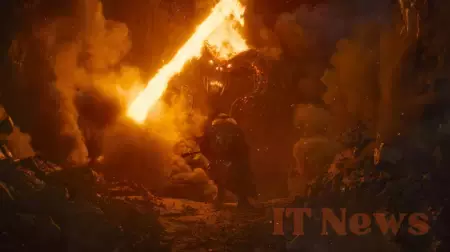The Balrog is one of the most formidable adversaries faced by the heroes of The Lord of the Rings, a gigantic monster that even managed to defeat the mighty Gandalf. But there is not just one Balrog, but several Balrogs, all sharing a long and relatively unknown history. From their place in Tolkien's writings to their role in Peter Jackson's films and the expanded universe, here are seven facts you (maybe) don't know about Balrogs.
#7 Peter Jackson's films changed this important detail about the Balrog (canon)
In the film adaptation of The Lord of the Rings, the Balrog, despite its impressive appearance, is deprived of its greatest assets: its intelligence and mastery of magic. In Peter Jackson's films, he is portrayed as a brutal, almost animal-like creature, reacting on pure instinct, either drawn to the One Ring or defending his lair against intruders. However, in Tolkien's books, the Balrog is described as a cunning and powerful magician, capable of casting formidable counter-spells against Gandalf. By forgetting his "wizard" side to focus on his monstrous and animal aspect, the films simplified this terrifying figure, and took the risk of reducing some of the stakes for a Gandalf who, here, unwittingly confronts a being who resembles him much more than he would like.
#6 Are Balrogs demons? (canon)
In Tolkien's universe, the term "demon" refers to spirits corrupted by Melkor/Morgoth, the first Dark Lord. These beings, called Úmaiar in Quenya, are Maiar who have fallen into evil. Among them, some became the terrifying Balrogs, chief servants of Morgoth. Their spiritual origin and deep corruption closely resemble demons, especially since Elven stories often refer to them as rauko or raug, words meaning "demon." It is clear that Tolkien drew on quasi-religious imagery to forge his Balrogs, their fall directly evoking that of Lucifer and the creation of demons in the Christian tradition.
In certain adaptations such as role-playing games (Middle-earth Role Playing, The Lord of the Rings Roleplaying Game) or video games (The Lord of the Rings Online), the notion of demon is further expanded. Many evil creatures are thus classified as demons: Balrogs, vampires, ice demons (Helegrogs), or formless spirits (Bandúrhoth). In these works, Balrogs can even summon other infernal spirits such as the Regmyl. Here too, these adaptations reinforce the image of Balrogs as demonic incarnations of primordial evil, close to the classic vision of the demon.
#5 Balrog is not the Street Fighter you think (behind the scenes)
In Street Fighter II, the character that Western gamers know as Balrog is a boxer inspired by Mike Tyson. However, in Japan, this character was originally called Mike Bison. This not-so-subtle pun at least had the advantage of making it clear where the character's inspiration was, except that... To avoid any legal issues during the American localization, Capcom swapped the names: Mike Bison became Balrog, except that... Balrog was originally the name of the Spanish warrior with a claw and a mask. And while the names of the two characters could have simply been swapped, a new character enters the fray.
Indeed, the Spanish Balrog will be named Vega, except that... Vega is the original name of the game's final boss, who will now be renamed M. Bison. Thus, in the Japanese version, Balrog initially referred to a Spanish fighter armed with a claw. This game of musical chairs makes any comparison with Tolkien's Balrog particularly risky: in The Lord of the Rings, the Balrogs are demons of fire and shadow, a far cry from an American boxer and a Spanish ninja. Despite some internet speculation, no official connection has been established between Tolkien and Street Fighter.Even today, this curious mix remains a source of confusion among fans.
#4 Why did the Balrog hide in the soil of Moria? (canon)
The Balrog we discover in The Fellowship of the Ring never chose Moria out of love for the majestic halls built by the Dwarves. An ancient and evil creature, this demon is a Maiar corrupted by Morgoth, the former Dark Lord. After his master's defeat in the War of Wrath, the Balrog found refuge in the depths of Middle-earth. Indeed, beneath the mountains already existed a network of tunnels, fashioned during the creation of the world and partially dug by nameless creatures (which we discussed in detail here). It was in these dark abysses that the Balrog hid for millennia. Much later, the Dwarves founded Moria, exploiting the riches of the mountains without knowing what lay dormant beneath. It was only during the Third Age, by digging too deep, that they awakened the ancient creature, which was neither a builder nor a former resident, but an opportunist taking advantage of the comfort of these galleries.
#3 The Warhammer saga had copyright issues with the Balrog (backstage)
In the first editions of Warhammer In Fantasy, the Balrog character appeared as a major demon, inspired by Tolkien's creatures. However, as the saga became more popular, Warhammer faced copyright issues regarding the use of the name "Balrog." To avoid confusion with the Lord of the Rings universe, the Balrog's name was changed to Baalrûkh. However, if the name "Balrog" has disappeared from Warhammer, players and readers of Tolkien are not mistaken.
Indeed, the Baalrûkh is described as a major demon, linked to fire and fire magic, and known for its unpredictable character and destructive power. The Baalrûkh is a formidable entity, capable of manipulating fire and casting powerful spells. On the other hand, unlike the monster in Tolkien's writings, the Baalrûkh is physically described in detail as being large and having bat-like wings, a description that seems, ironically, to have inspired recent depictions of the Balrog.
#2 A Balrog ended up frozen (Expanded Universe)
In the video game Shadow of War, Tar Goroth, an ancient and fearsome Balrog, emerges from the flames of Gorgoroth after centuries of slumber. Once corrupted by Morgoth, he is destined to sow chaos once again. Sauron then attempts to harness his power by sending Zog, an orc necromancer, to rally him to his cause. But the indomitable Tar Goroth slaughters his potential allies; Zog, the necromancer, narrowly survives, while the Balrog escapes. Faced with this threat, Talion, the hero of the games, allies himself with Carnán, a shapeshifting nature spirit. Together, they pursue Tar Goroth to the icy lands of Seregost. There, on a frozen lake, a fierce battle begins.
Carnán, in the form of a drake (a hybrid creature created by Sauron, a cross between a dragon and a flying mount of the Nazgûl), and Talion join forces to defeat the demon. Finally, the Balrog is thrown into waters so icy that they can hold it and contain the flames that animate it. However, Zog, the necromancer, resurfaces and attempts to free Tar Goroth. Talion and Celebrimbor intervene in time to stop the ritual and definitively defeat Zog. Thanks to the courage of the heroes and the intervention of Carnán, Middle-earth is spared from the destructive fury of a now-frozen Balrog.
#1 The Blue Mages faced a Balrog (Expanded Universe)
In the expanded universe offered by the video game The Lord of the Rings Online, a new Balrog appears: Thaurlach. Born in the darkness of the First Age, Thaurlach was a Maia who was twisted by Morgoth to become one of his most terrifying Balrogs. He sowed terror among the free peoples before finally being chained deep in the abyss known as the Rift of Nûrz Ghâshu. This victory over the monster was the work of the mysterious Blue Mages, allied with an elf named Glathlírel, who managed to subdue him.
Centuries pass, and Thaurlach remains locked in the Rift of Nûrz Ghâshu, a cursed abyss guarded by the Eldgang, an ancient people dating back to the most remote ages of lore. Unfortunately, the imminent return of Sauron stirs Middle-earth, and a monstrous being from an unidentified population appears: the Ever-seer. The latter releases the powerful Balrog, who breaks his chains and once again threatens the free peoples.
Fortunately, the Blue Wizards, uniting their power with that of the elf Glathlírel and heroes from all over Middle-earth, manage to purify the corrupted waters of the Rift of Nûrz Ghâshu and weaken the beast. Finally, as Thaurlach falters, it is one of the greatest heroes Tolkien imagined, the elf Glorfindel himself, who joins the battle. It is Glorfindel who will deliver the final blow, defeating Thaurlach. The Balrog is then not only physically defeated, but the alliance of the different forces that opposed him condemns his soul to never again incarnate on Middle-earth.
And to discover even more about Tolkien's world of monsters, we offer our files on the Goblin King, the Uruk-hai and the Nazgûl.






0 Comments